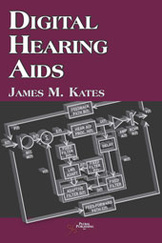Publication
Digital Hearing Aids
- Details:
- 464 pages, Illustrated (B/W), Softcover, 6 x 9"
- ISBN13:
- 978-1-59756-317-8
- Release Date:
- 04/01/2008
Overview
The first book available on the subject, Digital Hearing Aids provides an overview of the signal-processing strategies implemented in modern digital hearing aids. Algorithms ranging from dynamic-range compression and directional microphones to sound classification and binaural noise suppression are clearly explained. The basic equations describing the signal-processing algorithms are presented along with full explanations for those less comfortable with the mathematics, and each processing strategy is accompanied by a summary of its effectiveness. The text is intended for a graduate audiology course in hearing aids and hearing-aid technology.
Reviews
H. Martin, Journal of Laryngology and Otology (2009):
"I was a little daunted when I flicked thought the book, due to the many mathematical equations and circuit diagrams ... However, I need not have worried, as the book is very well written and it is possible to follow the explanations without fully appreciating the details of the equations. ... An excellent reference resource for those involved in selecting and programming hearing aids and counselling users in the limitations of their aids."Denise Hoysack, AuD, CCC-A, Otology & Neurotology (2010):
"The author does a good job of explaining the complexities involved, the capabilities, and constraints of signal processing. Additionally, the book is littered with mathematical equations, graphs, charts, and figures to ease the difficulties of understanding the concepts discussed."Ron Brouillette, PhD, Advisory Group on the Prevention of Hearing Impairments (2009):
"... The text is easily understood and complete with specifics useful to those who desire to stay current with digital hearing aids technology."
- Preface
- Hearing-Aid Technology
- Types of Hearing Aids
- From Analog to Digital
- Digital Circuit Components
- Batteries
- Concluding Remarks
- References
- Signal Processing Basics
- Signal and System Properties
- Discrete Fourier Transform
- Filters and Filter Banks
- Block Processing
- Digital System Concerns
- Concluding Remarks
- References
- The Electroacoustic System
- Hearing Aid System
- Head and Ear
- Microphone and Receiver
- Vent Acoustics
- Occlusion Effect
- Concluding Remarks
- References
- Directional Microphones
- Hearing-Aid Microphones
- Directional Response Patterns
- Frequency Response
- Magnitude Frequency Response
- Microphone Mismatch
- Interaction with Vents
- Microphone Noise
- Microphones on the Head
- Microphone Performance Indices
- Rooms and Reverberation
- Benefit in the Real World
- Concluding Remarks
- References
- Adaptive and Multi-Microphone Arrays
- Two-Microphone Adaptive Array
- Delay-And-Sum Beamforming
- Adaptive Arrays
- Superdirective Arrays
- Widely-Spaced Arrays
- Array Benefits
- Concluding Remarks
- References
- Wind Noise
- Turbulence
- Hearing-Aid Measurements
- Signal Characteristics
- Wind-Noise Reduction
- Concluding Remarks
- References
- Feedback Cancellation
- The Feedback System
- Gain-Reduction Solutions
- Adaptive Feedback Cancellation
- Processing Limitations
- Concluding Remarks
- References
- Dynamic-Range Compression
- Does Compression Help?
- Algorithm Design Concerns
- Single-Channel Compression
- Multi-Channel Compression
- Frequency-Domain Compression
- Frequency Warping
- Concluding Remarks
- References
- Single-Microphone Noise Suppression
- Properties of Speech and Noise Signals
- Low-Level Expansion
- Envelope Valley Tracking
- Bandwidth Reduction
- Envelope Modulation Filters
- Concluding Remarks
- References
- Spectral Subtraction
- Noise Estimation
- Wiener Filter
- Spectral Subtraction
- Algorithm Effectiveness
- Concluding Remarks
- References
- Spectral Contrast Enhancement
- Auditory Filters in the Damaged Cochlea
- Spectral Valley Suppression
- Spectral Contrast Modification
- Excess Upward Spread of Masking
- F2/F1 Ratio
- Processing Comparison
- Combining Spectral Contrast Enhancement with Compression
- Concluding Remarks
- References
- Sound Classification
- The Rationale for Classification
- Signal Features
- Feature Selection
- Classifier Algorithms
- Classification Examples
- Concluding Remarks
- References
- Binaural Signal Processing
- The "Cocktail Party" Problem
- Signal Transmission
- Binaural Compression
- Binaural Noise Suppression
- Dichotic Band Splitting
- Concluding Remarks
- References
- Index
About The Author
James M. Kates, EE holds the position of Research Fellow with hearing-aid manufacturer GN ReSound. He is also an Adjunct Professor in the Department of Speech Language and Hearing Sciences at University of Colorado in Boulder. Prior to moving to Colorado, he was Research Scientist in the laboratory of Harry Levitt at the City University of New York. He received the BSEE and MSEE degrees from the Massachusetts Institute of Technology in 1971, and the professional degree of Electrical Engineer from M.I.T. in 1972. He has developed many of the signal-processing algorithms implemented in the GN family of hearing aids, including the DFS feedback cancellation algorithm and the Warp-17 frequency-warped dynamic-range compression algorithm. He is a Fellow of the Acoustical Society of America and a Fellow of the Audio Engineering Society, and is the author or co-author of 47 technical papers and holds 17 US patents with seven patents pending. A widower, he resides in Niwot, Colorado.
Related Titles
Modern Hearing Aids
H Gustav Mueller, Todd A. Ricketts, Ruth Bentler
472 pages, Illustrated (B/W), Hardcover, 8.5 x 11"
Basics of Audiology
Jerry L. Cranford, Ph.D., M.C.D., C.C.C.-A.
144 pages, Illustrated (B/W), Softcover, 6 x 9"
School Professionals Working with Children with Cochlear Implants
Patricia M. Chute, Mary Ellen Nevins
239 pages, Illustrated (B/W), Softcover, 6 x 9"
Professional Communication in Audiology
Virginia Ramachandran, Brad A. Stach
160 pages, Illustrated (B/W), Softcover, 6 x 9"
Consultative Selling Skills for Audiologists
256 pages, Illustrated (B/W), Softcover, 6 x 9"
Modern Hearing Aids
Ruth Bentler, H Gustav Mueller, Todd A. Ricketts
748 pages, Illustrated (B/W), Hardcover, 8.5 x 11"
Quality in Audiology
336 pages, Illustrated (B/W), Softcover, 6 x 9"
Everyday Audiology
224 pages, Illustrated (B/W), Softcover, 7 x 10"
Sandlin's Textbook of Hearing Aid Amplification
Edited by: Michael J. Metz
776 pages, Illustrated (B/W), Softcover, 7 x 10"


















